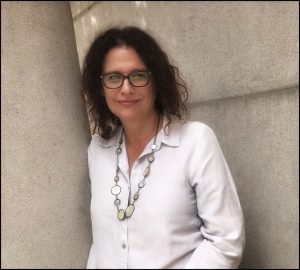Name: Adrienne Kochman
Hometown: Chicago, IL
Current Positions: Curator, Ukrainian Institute of Modern Art; Lecturer, School of the Art Institute of Chicago
Professional Interests: modern art history
Why did you decide to join the Shevchenko Scientific Society?
I joined because I was interested in having access to scholarly work and the practitioners whose interests/research overlapped with my own, as it could apply to art history – an interdisciplinary field. More specifically, I’m interested in recuperating Ukrainian modern art history, and seek to understand the intellectual, strategic and political underpinnings for its narrative or lack thereof. My work at the Ukrainian Institute of Modern Art (UIMA) offers me the opportunity to research and explore elements of this larger narrative which arguably continues to evolve and rebuild as curators, artists, historians, art historians, and other scholars shed new information.
How did your interest in Ukrainian culture and society influence your career path?
My mother is Ukrainian, a WW2 refugee from Poltava and an artist – Alexandra Diachenko Kochman [she was a Shevchenko Society member for many years and supporter of its purpose], so my upbringing with art and culture in a number of forms was natural, although not exclusively Ukrainian. My career path was in the arts and over time I chose art history for its interdisciplinary scope, intellectual growth, and interface with the public. I was Associate Professor of Art History and Adjunct Professor of Gender and Women’s Studies at Indiana University Northwest for a number of years before I became curator at UIMA. I continue to teach at the School of the Art Institute of Chicago part time. I consider myself a curator, writer and educator.
What is your current project at UIMA?
UIMA exhibits a wide variety of contemporary art, and it is dedicated to showcasing non-Ukrainian Chicago artists as well. UIMA’s founding in 1971 was motivated by activism – to provide a platform for the development of contemporary art where other institutions, governments, ideologies, suppressed or destroyed it, specifically former Soviet Ukraine. UIMA’s core focus was always Ukrainian or Ukrainian-American, -Canadian, etc. non-traditional art, yet it also acknowledged that artistic developments often cross cultural and national boundaries, experienced by those same artist founders who had trained in schools in the U.S., such as Konstantin Milonadis.
Exhibitions in my experience provide a widely accessible platform for educating and exposing pieces of that narrative to a Ukrainian and non-Ukrainian audience, such as the forthcoming ‘Michel Andreenko Revisited’ or the recent 2018 ‘Contemporary Ukrainian Graphics from the Turn of the XX/XXI Century’ which traveled from Ukraine.
What career advice would you give for new members of the Shevchenko Scientific Society?
Exhibitions generate dialogue with the public, through content deemed relevant to current conversations on art, culture, and politics. I would encourage anyone curating – from an art museum, history museum, university special collections curator or librarian – to utilize the valuable resources the Shevchenko Society has to offer to inform their projects, through publications, archival materials, lectures and networking.

